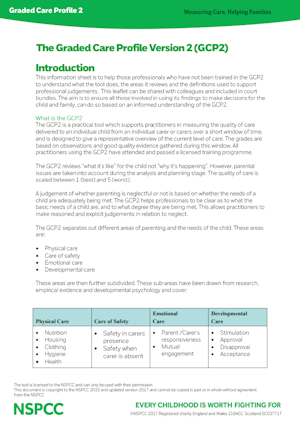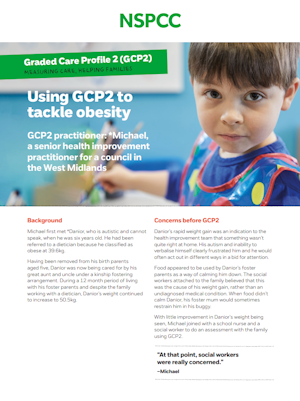Neglect
Neglect is the most common reason for a child to be the subject of a Child Protection Plan in the UK and research from the NSPCC tells us that 1 in 7 secondary school age children and 1 in 20 children under 11 in the UK have been neglected at some point.
To help combat the neglect of children in Tameside, Tameside Safeguarding Children Partnership (TSCP) has developed and published its multi-agency Neglect Strategy.
Tameside Neglect Strategy
This strategy was created in collaboration between all agencies within Tameside Safeguarding Children Partnership. The agencies include Children’s Services, Health, Police and Education. (July – November 2024)
Neglect is defined in Working Together to Safeguard Children (2023) as:
The persistent failure to meet a child's basic physical and/or psychological needs, likely to result in the serious impairment of the child's health or development. Neglect may occur in pregnancy as a result of maternal substance abuse.
Once a child is born, neglect may involve a parent or carer failing to:
- Provide adequate food, clothing and shelter (including exclusion from home or abandonment).
- Protect the child from physical and emotional harm or danger.
- Ensure adequate supervision (including the use of inadequate caregivers)
- Ensure access to appropriate medical care or treatment.
It may also include neglect of, or unresponsiveness to, a child's basic emotional needs.
Recognising and Assessing Neglect.
Neglect is difficult to assess, and it is important to be professionally curious about reasons for a child/parent/carer’s behaviours, presentation and situation.
The following list (not exclusive) are common indicators of neglect:
- ability or motivation of the parent/carer to recognise and meet the needs of the child is compromised
- clothing and presentation of the child – e.g. inappropriate clothing for the winter; personal hygiene dirt and odour
- frequent presentations at A&E
- home conditions are dirty, unkempt and offer poor safety provision
- inadequate or poor nutrition
- lack of interest in child’s schoolwork or presenting behaviours
- lack of uptake of immunisations
- medical care is inconsistent where treatment for minor health problems or the essential treatment for serious illnesses are not sought
- parental behaviour is a cause of concern – e.g. substance misuse, domestic abuse, housing instability
- poor dental hygiene and care
- repeated incidents of missing from home or school
- school attendance is poor or consistently late
Graded Care Profile 2
TSCP became licenced to use the Graded Care Profile 2(GCP2) in December 2023. The tool has been introduced to support all practitioners to assess the level of neglect a child may be experiencing. GCP2 has been provided by the NSPCC and was developed by Dr. Srivastava, a Consultant Paediatrician, following his research the University of Nottingham in 1995. It is an evidenced-based assessment tool for measuring the quality of care provided by a parent or carer in meeting the needs of their child’s needs. The tool uses a graded scale from 1 to 5 by capturing the levels of emotional and physical care through the eyes of the child.
GCP2 supports with assessing the level of neglect that a child may be experiencing. It measures the quality of care delivered to an individual child over a window of time and can be used across the continuum of need in the Tameside Threshold Document.
The tool should be used:
Where neglect is suspected:
- to assess the current quality of care
- to provide a baseline measurement of the quality of care
- to target intervention
- to monitor progress after interventions
Where there is a concern regarding the quality of care:
- to target resources
- to understand emotional or behavioural outcomes for a child
- to understand educational outcomes for a child.
GCP2 is a licenced tool and therefore practitioners need to attend a 1-day training course to be able to use the tool. Training should be booked via the training page of the TSCP website Training - Tameside Safeguarding Children Partnership
There is an expectation that all practitioners working with children and families in Tameside should understand the tool and work together to complete the tool where required.
What does the GCP2 measure?
GPC2 measures the quality of care given to an individual child over a short period of time. The care given is graded between 1 and 5, with 1 being excellent and 5 being a serious cause for concern in areas of a child’s needs. The grades are based on the extent to which the needs of the child are currently being met and the commitment of the parent/carer to the child in relation to specific areas of care.
The areas of care are based on Maslow’s Hierarchy of Needs – physical care, care of safety, emotional care (love and belonging), and developmental care (care of esteem) which are then further sub-divided within the tool.
The GCP2 doesn’t explore reasons why a particular level of care is given to a child. However, it encourages further exploration of the reasons at the analysis stage and this is supported by report and records completed by the practitioner.
An introduction to the GCP2 is given in this short video from the NSPCC:
Use of the GCP 2
Anyone involved in evaluating the quality of parental care (particularly in cases of neglect) can use the tool. There is no requirement to be a Social Worker but there is a need to have an understanding of the child’s needs and to have completed the GCP 2 training.
A full assessment can be carried out if practitioners have access to the home and observe care. Otherwise, an assessment can be completed with input from other professionals in current contact with the family.
GCP 2 information for professionals
GCP 2 Infographic
GCP 2 Case study pack explains the multi-faceted benefits of GCP2 in a multi-agency environment
For more information about neglect and the impact on children go to the NSPCC website: Neglect is also Child Abuse: Know All About It | NSPCC
Actions to take if a Child/Young Person is in immediate risk of harm
If the situation is immediately dangerous for the child, then ring 999 and ask for the Police.
If you think a child is being abused, mistreated, or you have concerns about a child's wellbeing, please contact the Multi Agency Safeguarding Hub.
During office hours, please contact the Multi Agency Safeguarding Hub on 0161 342 4101.
Office Hours
| Monday to Wednesday: | 8.30am - 5pm |
| Thursday: | 8.30am - 4.30pm |
| Friday: | 8.30am - 4pm |
Out of office hours, contact 0161 342 2222
If you have evidence of neglect, please complete a Multi-Agency Request for Service (MARS) attaching the evidence, indicating the worries, what’s working well and what needs to happen.




